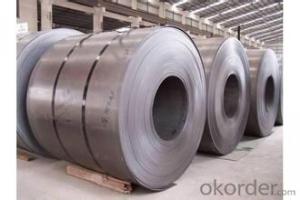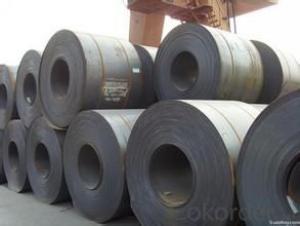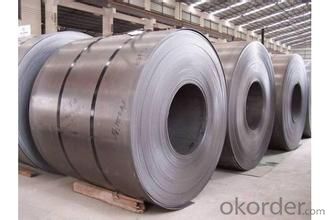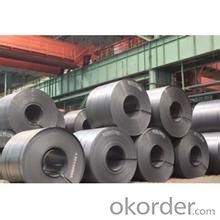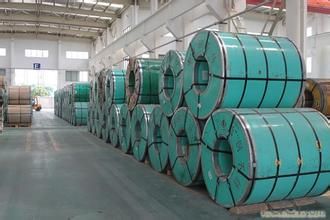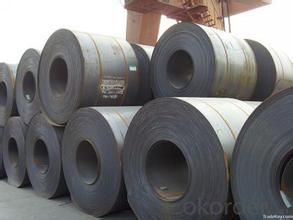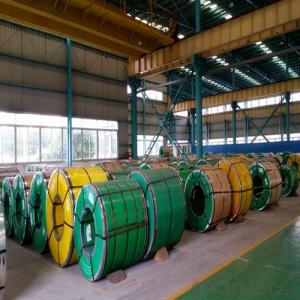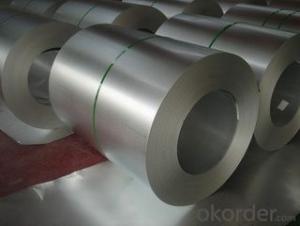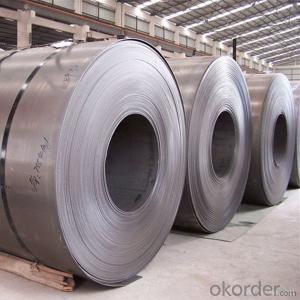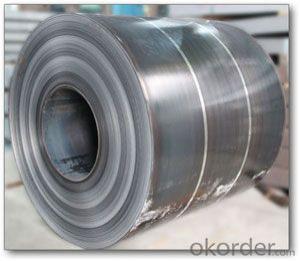Hot Rolled Steel Sheet/ Coil in Good Quality
- Loading Port:
- Tianjin
- Payment Terms:
- TT OR LC
- Min Order Qty:
- 100 m.t.
- Supply Capability:
- 500000 m.t./month
OKorder Service Pledge
OKorder Financial Service
You Might Also Like
Rolled to its final dimensions while it’s hot enough to scale, our hot-rolled steel is an amalgamation of the various qualities of steel. It can be in the form of plates, sheets and coils. Our Hot-Rolled Steel Sheets and Coils are applied to a wide range of uses such as automobile, electrical appliance, machinery manufacturing, container manufacturing, shipbuilding, bridge, pipeline, and receive high acclaim from our customers for its excellent quality.
Product Description:
HOT-ROLLED STEEL COIL
Hot rolled low hardness, easy processing, good ductility.
Available specification:
| thickness | width(mm) | length(mm) | coil inside diameter(mm) | |
HOT ROLLED STEEL COIL | 1.5-25 | 600-2000 | 762 | |
HOT ROLLED STEEL STRIP | 1.5-20 | 30-720 | 762 | |
HOT ROLLED STEEL PLATE | 6-700 | 500-4500 | 4000-18000 | |
HOT ROLLED STEELSHEET | 1.2-25 | 50-2000 | 0-18000 |
we can supply all these inndustrial materials with reasonable price and high quality.
We can ensure that stable quality standards are maintained, strictly meeting both market requirements and customers’ expectations. Our products enjoy an excellent reputation and have been exported to Europe, South-America, the Middle-East, Southeast-Asia, Africa and Russia etc.. We sincerely hope to establish good and long-term business relationship with your esteemed company.
- Q: What are the different types of coil edge trimming machines?
- There are several types of coil edge trimming machines available in the market. Some common types include manual coil edge trimmers, pneumatic coil edge trimmers, and automatic coil edge trimmers. Manual coil edge trimmers require manual operation and are suitable for low volume production. Pneumatic coil edge trimmers use compressed air to power the trimming process, making them faster and more efficient. Automatic coil edge trimmers are fully automated machines that can handle high volume production, enhancing productivity and reducing labor requirements.
- Q: What are the dimensions of a steel coil?
- The dimensions of a steel coil can vary depending on its intended purpose and specifications. However, typical dimensions can range from 0.15mm to 10mm in thickness, and from 600mm to 2,000mm in width. The length of a steel coil can vary as well, typically ranging from 1,500mm to 6,000mm.
- Q: What are the different types of welding used for steel coils?
- Steel coil fabrication involves the utilization of various welding techniques, each catered to specific requirements and applications. Here, we present some commonly employed welding methods for steel coil fabrication: 1. Stick welding, also known as Shielded Metal Arc Welding (SMAW), utilizes a flux-coated electrode and an electric current to generate an arc between the electrode and the base material. SMAW is a versatile and extensively used technique suitable for a range of steel coil applications. 2. Gas Metal Arc Welding (GMAW), also referred to as MIG (Metal Inert Gas) welding, employs a continuous wire electrode and a shielding gas to safeguard the weld pool against atmospheric contamination. GMAW is renowned for its high welding speed and ease of automation, making it a favored choice for steel coil manufacturing. 3. Flux-Cored Arc Welding (FCAW) shares similarities with GMAW, but employs a tubular electrode with flux inside. The flux serves as both the shielding gas and added alloying elements, resulting in enhanced efficiency and weld quality. FCAW is often employed for high-speed welding applications in steel coil fabrication. 4. Gas Tungsten Arc Welding (GTAW), also known as TIG (Tungsten Inert Gas) welding, employs a non-consumable tungsten electrode and an inert gas, typically argon, to protect the weld area. GTAW delivers high-quality, precise welds with exceptional control over heat input, rendering it suitable for thin steel coil materials and critical welding scenarios. 5. Submerged Arc Welding (SAW) involves the use of a continuously fed wire electrode and a granular flux that covers the weld area. The arc is submerged beneath the flux, providing excellent protection and minimizing the need for post-weld cleaning. SAW is commonly employed for welding thick steel coils due to its high deposition rates and deep penetration capabilities. These examples highlight the diverse range of welding techniques employed in steel coil fabrication. The selection of the appropriate welding method depends on factors such as the specific steel grade, thickness, desired weld quality, production speed, and cost considerations. It is crucial to choose the suitable welding technique to ensure the longevity and performance of steel coils across different applications.
- Q: What are the different methods of embossing steel coils?
- There are several methods of embossing steel coils, including roller embossing, heat embossing, and laser embossing. Roller embossing involves using engraved rollers to press a pattern onto the steel surface. Heat embossing uses heat and pressure to create raised designs on the steel coils. Laser embossing utilizes laser technology to etch intricate patterns onto the steel surface. These methods allow for the creation of unique textures and designs on steel coils for various applications.
- Q: i know stainless steel swords are decoration, what metal is ok for a sword that is usable
- Why the interest in a 'usable' sword ~~ are you really going to use it?
- Q: what is the chemical process that makes steel harder when it is heated and cooled rapidly?what does the heating of it do to the atoms?what does the cooling of it do to the atoms?what makes tempered steel so strong compared to untempered steel?
- You can't temper all steels. Generally the material must be a high-carbon or tool steel. Different alloys temper differently, and tempering is usually done to get a specific set of characteristics, so you must know what you are working with and use the right methods and temperature. If you do it wrong, the material may be hard but too brittle for the purpose or have other issues. It can be simple, such as heating to a dull red, carbonizing the surface (use an acetylene rich flame until it blackens the surface) and oil quenching. Do that to a piece of tool steel (like a screwdriver) and it will case (surface) harden it to the point you can't scratch it with a file. Tempering changes the way the molecular structure in the metal is linked and oriented.
- Q: Can steel coils be embossed?
- Yes, steel coils can be embossed. Embossing is a process that involves creating raised or sunken designs on a material, and it can be applied to steel coils to add texture or decorative patterns.
- Q: I'm assuming that brass is flexible, expands and then bounces back to it's original shape. But if aluminum and steel expand and don't contract wouldn't they cause guns to jam more often for example?
- This Site Might Help You. RE: Why can aluminum and steel casings not be used for reloading? I'm assuming that brass is flexible, expands and then bounces back to it's original shape. But if aluminum and steel expand and don't contract wouldn't they cause guns to jam more often for example?
- Q: Obviously this is an easy question for anyone who works with metal. However, I am currently writing a book and had an idea that had to do with these two metals. Is it possible for gold to be folded into steel while it is being forged? Do 3-metal alloys exist? If this is not possible with current metal-working techniques and technology, what would be needed to make it possible? And finally, what exactly would the mixing of these two yield? A weak metal? A brittle metal? How would it compare to iron or gunmetal? If you have no idea, please offer speculations. Thank you!
- Well put it this way you cant gold steel but you can steel gold Kidding but seriously you can but ther would be no point the steel would be weaker and gold is expensive
- Q: What are the challenges in coil leveling for high-strength steel?
- Coil leveling for high-strength steel poses several challenges that need to be addressed in order to achieve optimal results. One of the main challenges is the inherent hardness and strength of the steel itself. High-strength steel is specifically designed to have enhanced mechanical properties, such as tensile strength and hardness, which make it more difficult to deform and shape. The high-strength nature of the steel requires specialized leveling equipment that can apply sufficient force to overcome its resistance to deformation. This may involve using stronger and more durable leveling rollers or increasing the pressure exerted during the leveling process. Failure to apply the appropriate force can result in incomplete leveling, leading to residual stress and potential dimensional inaccuracies in the final product. Another challenge in coil leveling for high-strength steel is the potential for springback. Springback refers to the tendency of the material to revert to its original shape after being deformed. High-strength steel is particularly prone to springback due to its higher elastic modulus. This can result in uneven leveling and dimensional variations in the coil. To mitigate springback, advanced leveling techniques may be employed, such as overbending or pre-bending the steel. Overbending involves bending the steel beyond the desired level, allowing it to spring back to the desired shape. Pre-bending, on the other hand, involves intentionally bending the steel in the opposite direction before leveling it, counteracting the effects of springback. These techniques require precise control and expertise to ensure accurate leveling. Additionally, high-strength steel often has a more pronounced yield point, which is the stress level at which permanent deformation occurs. This can make it more challenging to achieve consistent and uniform leveling throughout the coil. Proper adjustment of the leveling equipment and careful monitoring of the leveling process are necessary to address this challenge effectively. Furthermore, high-strength steel coils are often thinner and more sensitive to surface imperfections. The leveling process must be carefully regulated to avoid causing damage to the steel surface, such as scratches or indentations. This may involve utilizing softer leveling rollers or implementing protective measures, such as cushioning materials or coatings, to prevent surface defects. In summary, the challenges in coil leveling for high-strength steel revolve around its inherent hardness, springback tendencies, yield point behavior, and sensitivity to surface imperfections. Overcoming these challenges requires specialized equipment, advanced leveling techniques, precise control, and expertise to ensure accurate and high-quality leveling results.
Send your message to us
Hot Rolled Steel Sheet/ Coil in Good Quality
- Loading Port:
- Tianjin
- Payment Terms:
- TT OR LC
- Min Order Qty:
- 100 m.t.
- Supply Capability:
- 500000 m.t./month
OKorder Service Pledge
OKorder Financial Service
Similar products
Hot products
Hot Searches
Related keywords
